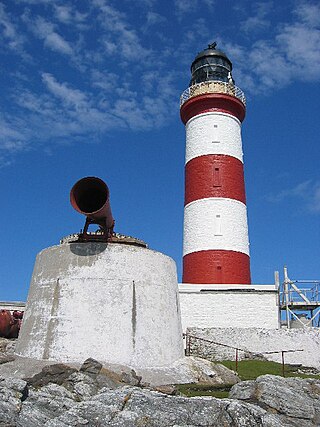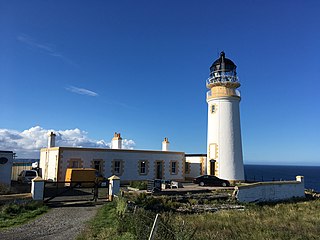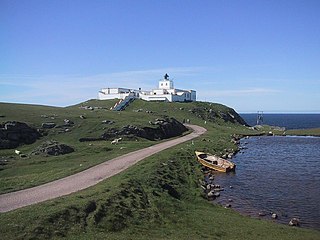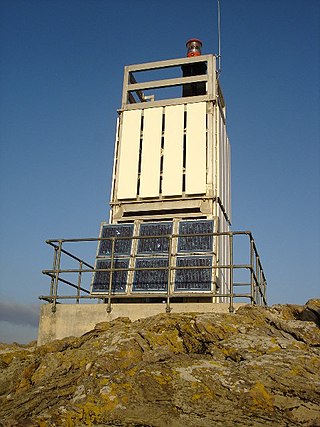
Bound Skerry is part of the Out Skerries group in the Shetland Islands. As well as being the most easterly island of that group, it is also the easternmost point of Scotland.

Duncansby Head is the most northeasterly part of both the Scottish and British mainlands, slightly northeast of John o' Groats. It lies approximately 20 km (12 mi) east-southeast of Dunnet Head, the northernmost point of both the Scottish and British mainlands. Duncansby Head is located in Caithness, Highland, in north-eastern Scotland. The headland juts into the North Sea, with the Pentland Firth to its north and west and the Moray Firth to its south.

The Tarbat Ness Lighthouse is located at the North West tip of the Tarbat Ness peninsula near the fishing village of Portmahomack on the east coast of Scotland. It was built in 1830 by Robert Stevenson and has an elevation of 53 metres (174 ft) and 203 steps to the top of the tower.

Cape Wrath Lighthouse at Cape Wrath was built in 1828 by Robert Stevenson and was manned until 1998, when it was converted to automatic operation by the Northern Lighthouse Board. It is located at the most North-Westerly point on the British mainland, in the traditional county of Sutherland within Highland Region. Durness is the closest village, 10 miles (16 km) to the south-east with Inverness around 120 miles (190 km) to the south.

The Tree Point Light is a lighthouse located adjacent to Revillagigedo Channel in Southeast Alaska, United States. It is located near the southernmost point of mainland Alaska.

Fife Ness is a headland forming the most eastern point in Fife, Scotland. Anciently the area was called Muck Ross, which is a corruption of the Scottish Gaelic Muc-Rois meaning "Headland of the Pigs". It is situated in the area of Fife known as the East Neuk, and forms the muzzle of the dog-like outline of the latter when viewed on a map. Ness is an archaic Norse word meaning "nose".

Hoo Stack is a small island off Nesting in Shetland. It is one and a half miles from the North Isle of Gletness. It is 34 metres (112 ft) at its highest point, and is home to a lighthouse, which was built in 1986.

Lunna Holm is a small island near Lunna Ness, in the Shetland Islands. It is 27 metres (89 ft) at its highest point.

Eilean Musdile (Mansedale) is an islet, and lighthouse to the south west of Lismore in the Inner Hebrides.

Rua Reidh Lighthouse stands close to the entrance to Loch Ewe in Wester Ross, Scotland.

Eilean Glas Lighthouse is situated on the east coast of the island of Scalpay in the Outer Hebrides of Scotland. It was one of the original four lights commissioned by the Commissioners of the Northern Lights, and the first in the Hebrides. These lighthouses were built by Thomas Smith.

Hyskeir Lighthouse was established in 1904. The 39 metres (128 ft) metre high lighthouse marks the southern end of the Minch, warning of the presence of the Mills Rocks, Canna, and Hyskeir itself. It was designed by David and Charles Stevenson and constructed by Oban contractor Messrs D & J MacDougall.

Neist Point Lighthouse is a lighthouse located on Neist Point on the Isle of Skye in Scotland. It was designed by David Alan Stevenson and was first lit on 1 November 1909. An aerial cableway is used to take supplies to the lighthouse and cottages.

The Tiumpan Head Lighthouse is an active lighthouse located in Tiumpan Head, Isle of Lewis, Outer Hebrides, Scotland.

The Ushenish Lighthouse is an active lighthouse located in South Uist, Outer Hebrides, Scotland.

Dunnet Head Lighthouse is an active 19th century lighthouse that stands on the 300-foot (91 m) cliff top of Easter Head on Dunnet Head. The lighthouse is 66 feet (20 m) tall and was built in 1831 by Robert Stevenson, grandfather of Robert Louis Stevenson. The lighthouse was automated in 1989, and the keepers were withdrawn. It is now checked remotely by the Northern Lighthouse Board operations centre in Edinburgh.

Corran Point Lighthouse is an active lighthouse located at Corran Point on the west side of the Narrows of Loch Linnhe, in Lochaber, Highland, Scotland. It was built in 1860 as a project by Thomas Stevenson and David Stevenson; it is a masonry tower with gallery, lantern and keeper's house which has become private property. The lighthouse emits an isophase light white, red or green according to the directions and was the first lighthouse to be automated in 1898.

Strathy Point Lighthouse is a remote former lighthouse located on the north coast of Sutherland, Scotland, and is situated on the coast close to the village of Strathy. Strathy Point was the first lighthouse in Scotland specifically built to be electrically operated. It was initially planned in 1953 and was completed by 1958. The lighting device itself was a two panel device with a focal length of 250mm with a 250watt light bulb, that gave a range of almost 26 miles. The lighthouse was originally fitted with a fog horn, which is no longer used.

North Ronaldsay Lighthouse was built in 1852 on the island of North Ronaldsay in the Orkney Islands, Scotland, 43 years after Dennis Head Old Beacon was deactivated. It lies at the north of the island at Point of Sinsoss , and boasts Britain's tallest land-based lighthouse tower. The old fog siren with notable red trumpet was replaced by an electric diaphragm-type horn. That horn was discontinued in favour of a Tyfon horn consisting of 8 mini-trumpets installed on the building that once housed the fog siren. The Tyfon horn gives three blasts every 60 seconds. The electric beeper horn now lies flat on the ground next to the fog signal building, and is still in service today.

The Point of Sleat Lighthouse is a lighthouse on Skye in the Inner Hebrides, Scotland. It was built in 1934 at the Point of Sleat at the southern end of the island. In 2003 the tower was dismantled and replaced by a concrete structure with a solar powered light.




















